Characteristics of Counterfeit Turkish Lira Banknotes
To be able to figure out whether a banknote is counterfeit or not, you should first know the features of genuine banknotes so that you can make a comparison. The basic features of genuine banknotes printed by the Central Bank are as follows:
Banknote Paper
The paper of a genuine banknote is 100% cotton fiber, and does not fluoresce under UV light. The paper is tinted with the dominant color of each denomination. Moreover, it is very resistant to soiling.
In contrast, counterfeit banknote paper fluoresces under UV light despite usually being covered by a special lacquer to avoid this.
Watermark
A genuine banknote incorporates a watermark of Atatürk's portrait and the denomination numeral, which can be seen in the unprinted white area when the banknote is held up to the light from either the obverse or reverse side.
Counterfeit banknotes either do not contain watermarks at all or they imitate the watermark with an imprint inside or on the paper.
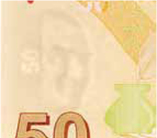 |
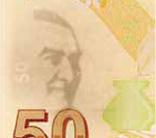 |
| Original | Counterfeit |
Security Fibers
Security fibers are incorporated into a genuine banknote during the production process by the Central Bank. They are invisible to the naked eye but fluoresce in blue and red under UV light.
Counterfeit banknotes attempt to imitate these security fibers through an imprint or the use of highlighters.
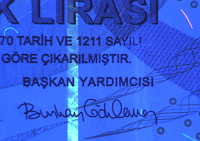 |
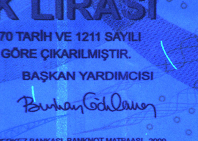 |
| Original | Counterfeit |
The Security Thread
A genuine banknote contains an embedded security thread which forms a continuous line displaying the denomination numeral and the letters ''TL'' when held up to the light. This thread fluoresces under UV light in blue, red or yellow depending on the denomination of the banknote.
Counterfeit banknotes attempt to imitate the security thread through an imprint.
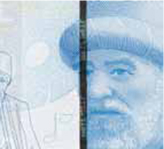 |
 |
 |
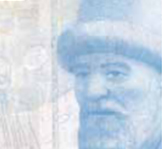 |
| Original | Original | Counterfeit | Counterfeit |
The Holographic Stripe Foil
The obverse right side of a genuine banknote contains a holographic stripe foil which displays colorful and shiny reflections when the banknote is viewed from different angles.
On the other hand, counterfeit banknotes imitate the holographic foil stripe by use of silvery and iridescent gilding.
 |
 |
 |
| Original | Counterfeit | Counterfeit |
Iridescent Stripe Application
The reverse side of a genuine banknote contains an iridescent stripe imprint which contains the denomination numeral and the letters ''TL''. This iridescent imprint reflects in a translucent yellow color.
Counterfeit banknotes attempt to produce a close imitation of the original imprint.
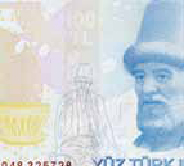 |
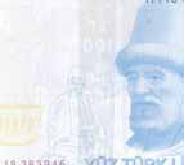 |
| Original | Counterfeit |
Intaglio Printing
The obverse side of a genuine banknote is printed using a special printing technique, which is applied to some text and numeral blocks as well as motifs, and creates an embossed effect that can be felt with the fingertips.
Counterfeit banknotes do not contain intaglio printing but some of them employ certain methods to imitate the embossed effect.
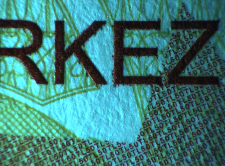 |
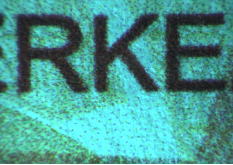 |
| Original | Counterfeit |
Latent Image
The obverse side of a genuine banknote contains a latent image within the heptagon shaped motif on the right side of the jacket of Atatürk's portrait. It is formed by lines running breadthwise and lengthwise, on which the denomination numeral can be seen when the banknote is held horizontally at eye level.
Counterfeit banknotes fail to produce the same latent image effect as in a genuine banknote.
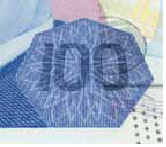 |
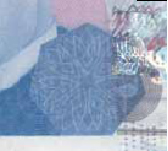 |
| Original | Counterfeit |
Micro Lettering
The obverse side of a genuine banknote contains micro lettering embedded in the star and crescent motif, which shows the denomination numeral and the letters ''TL''. These letterings are produced by the intaglio printing technique and can be read with a magnifying glass.
On counterfeit banknotes, the micro lettering areas cannot be read with a magnifying glass as they become distorted. However, certain printing techniques used in some counterfeit banknotes are able to increase the readability of the micro lettering.
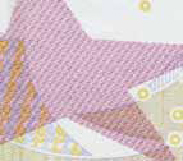 |
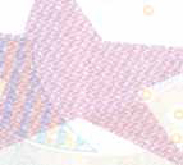 |
| Original | Counterfeit |
See Through Image
In a genuine banknote, the denomination numerals on the obverse and reverse sides complete each other, forming a see-through image, when the banknote is held up to the light.
See-through images are generally out of synch and distorted in counterfeit banknotes.
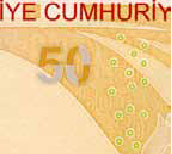 |
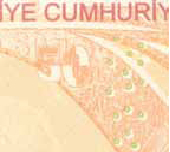 |
| Original | Counterfeit |
Ink with Fluorescent Effect
The obverse side of a genuine banknote contains the denomination numeral and the letters ''TL'' on Atatürk's portrait, which are printed with an ink with fluorescent effect causing them to fluoresce brightly under UV light.
Counterfeiters use a variety of methods to try to replicate the same fluorescent effect on counterfeit banknotes.
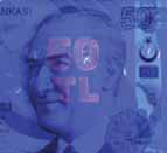 |
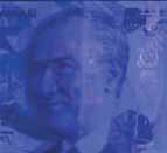 |
| Original | Counterfeit |
Serial and Sequence Numbers
The reverse side of a genuine banknote includes two serial and sequence numbers printed in black and red. The one printed with black ink fluoresces in green and the other printed with red ink fluoresces in red under UV light.
On counterfeit banknotes, the serial and sequence numbers printed with black ink do not fluoresce in green under UV light. However, some counterfeit banknotes may manage to cause the serial and sequence numbers in red to fluoresce in red under UV light.
 |
 |
 |
 |
| Original | Counterfeit |
Size Difference
Genuine banknotes come in different sizes depending on the denomination value, and the size of each denomination is separately specified by making a difference of 6 mm in the long side and 4 mm in the short side in dual groups.
Counterfeit banknotes are imitated in the same sizes as the genuine banknotes. However, some of them may display slight differences in width and length.
